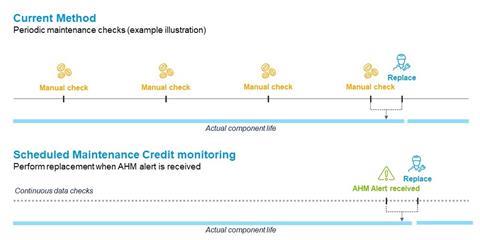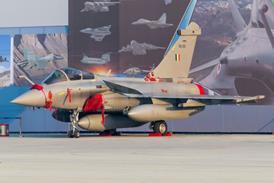Aircraft maintenance has been governed by a cautious approach that has helped ensure every decade has been safer for commercial aviation than the last, despite an exponential rise in passengers.
This thoughtful approach must and will continue as advances in aerospace technology and updated protocols in maintenance, repair and overhaul (MRO) are adopted. Regulators – working in concert with operators and OEMs, and acting on behalf of the travelling public – must be sure that any streamlining of inspection processes will never compromise a rigorous and dependable process.
In that context, Boeing is contributing to industry-wide efforts that could result in the biggest change since the early 1980s in the way maintenance checks are carried out – and so-called intelligent parts and ‘big data’ analytical tools are key to making it happen.
For operators, the development could lead to significant savings in time and cost without compromising robust safety and quality oversight. The first airplanes to benefit from the latest approach are already in service and their operators are increasingly seeing the advantages.
For more than 40 years, an aircraft’s maintenance schedule has been developed under the Maintenance Steering Group-3 or MSG-3 process. This results in a Maintenance Review Board Report (MRBR) that sets down the minimum maintenance requirements for any aircraft to ensure continued airworthiness.
The regime is overseen by an international committee comprising representatives of the FAA, EASA, and other National Aviation Authorities, as well as airline associations.
It is termed MSG-3 because there were previous MSGs. The first, in the 1960s, as passenger numbers began to soar, used decision logic to develop the concept of scheduled maintenance. MSG-2 saw the emergence of condition-monitored maintenance.
The current, but now four-decade-old, MSG-3 recognises the inherent reliability of systems and components, but still requires physical examinations by a mechanic at the aircraft.
A move to update MSG-3 to reflect advances in predictive maintenance techniques began in the 2010s, and finally resulted in regulatory changes – leading to an August 2023 revision of the 787’s MRBR permitting a much more extensive use of aircraft health monitoring.
Modern, clean-sheet aircraft are designed from the outset to be cutting-edge, from significant adoption of composites in the airframe to widespread use of digitally enabled systems to enhance the operation of traditional mechanical and hydraulic systems.
So, a new aircraft was the perfect candidate to be a pacesetter when it came to airplane health monitoring. Using rigorous analysis and real-world data, Boeing was able to demonstrate to the authorities that onboard data collection and subsequent monitoring could safely be substituted, or credited, for certain physical maintenance inspections.
Aircraft health monitoring works by utilizing onboard sensors to capture data from an aircraft and analyse the information remotely, alerting the OEM, operator or third-party MRO maintenance professional to potential actions needed to be taken with a component or system, or simply monitoring it for its optimal replacement time. The end-to-end process of incorporating aircraft health monitoring into a maintenance regime is sometimes referred to as Integrated Aircraft Health Management.
Integrated Aircraft Health Management arguably enhances a maintenance system, from operations to safety, because it means operators are not solely relying on physical inspections at set intervals. It also has a beneficial impact on the cost of maintaining an aircraft to the same rigorous standards, especially at a time when aircraft mechanic and technician availability is at a premium.

“That’s the motivation,” states Darren Macer, senior technical fellow, predictive maintenance and health management at Boeing.
There are other advantages of enhancing physical maintenance checks with a data-driven process. As well as a more efficient use of labour hours, MRO organisations can plan better by scheduling corrective actions with plenty of notice.
It can also potentially prolong component life. There is even a sustainable benefit, given that every maintenance event burns carbon, from powering a repair truck to setting up a mobile gantry or access platform.
While incorporating remote monitoring into the MRBR is new, aircraft health monitoring itself is not. Boeing has been offering it since the mid-2000s, with its Aircraft Health Management solution, as a way of helping airline customers avoid flight delays and aircraft on ground (AOG) disruptions.
The latest advance in aircraft health monitoring is part of an “evolution from corrective maintenance, through reliability centered and condition-based maintenance into true predictive maintenance”, says Macer. He adds: “It is all about replacing parts before they fail, and predicting what will happen so you can get ahead of any faults. By moving events from unscheduled maintenance to scheduled maintenance an operator can significantly improve the efficiency of their fleet and maintenance teams.”
So, what is next? Based on the tool’s success and the 787 MRBR revision, Boeing plans to roll it out to its legacy applicable widebody fleet, and then to every Boeing aircraft to the extent of its capability, says Jeff Miller, a Boeing systems lead of maintenance programmes engineering.
Providing an aircraft health monitoring option for future MSG-3 methodology could mean the development of an MSG-4 that will include far deeper integration with AHM capabilities, with an operator using predictions to remove outwardly healthy components before their in-service failure.
“We are already seeing benefits today, but we’ll see even bigger benefits in the future,” concludes Miller. “The really big change will come with the next generation of aircraft.”













































